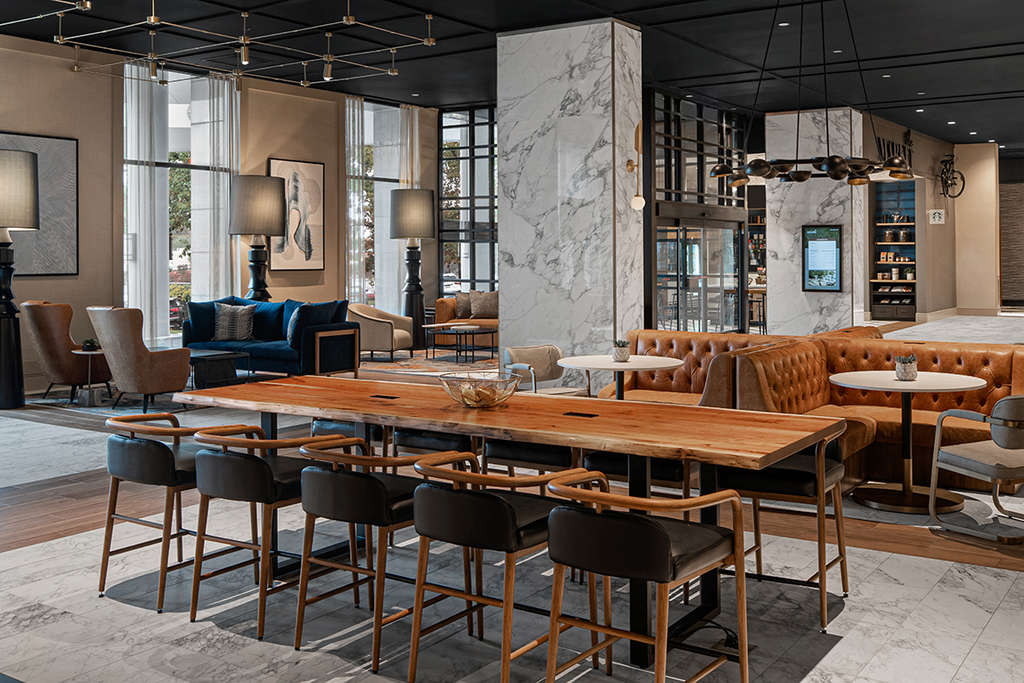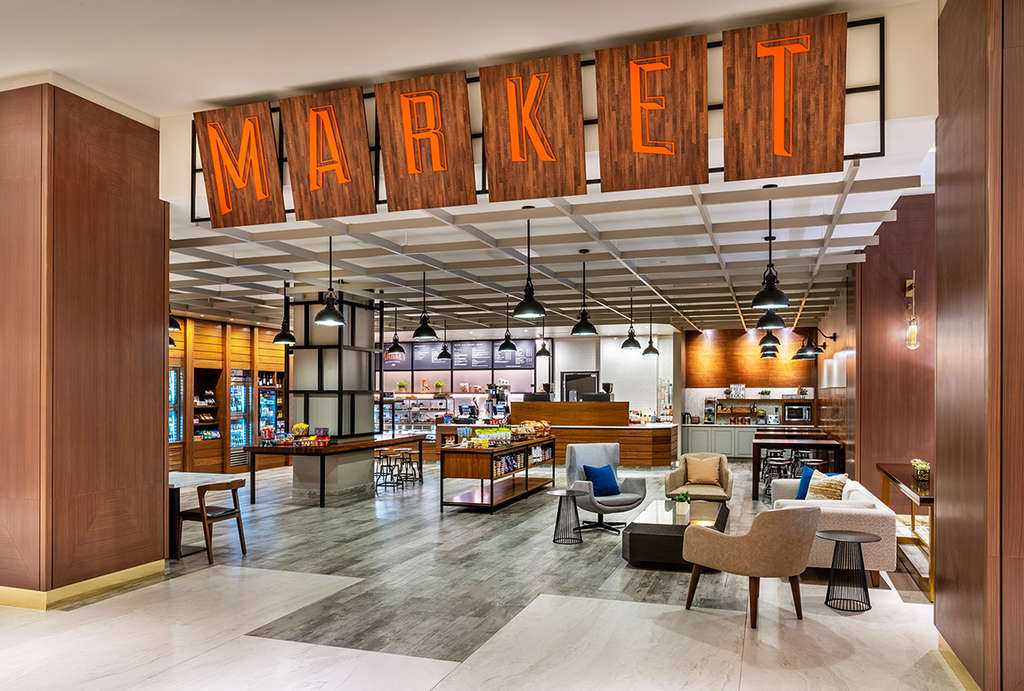Work From Hotel: How Hotel Design is Adapting to Accommodate the New Guest

During the pandemic, working from home became a way of life that grew out of necessity. After COVID subsided, people were hungry to travel again after being trapped at home. They realized that working from home did not mean one has to be at home or in the office to work. Technological advancements allow the office to travel where the laptop goes. Enter bleisure travel.
People now no longer separate business trips and leisure trips. An extra day or two can be tacked on to either side of the guests' trips to either work from the hotel or take a day for pleasure. In hotel economics of the past, the low occupancy stays for hotels were Thursday and Sunday nights. These nights are now the fastest growing rise in revenue. Guests get to add Friday and Monday to work, and Saturday and Sunday to relax.
While this happened more frequently in resorts, destination, or urban locations, this phenomenon is expanding to hotels in other locations, such as college towns, edge cities (suburbia with mass transit), and smaller suburban neighborhood town centers because people not only go on traditional vacations, but they also visit family and friends in lesser traveled locations. These guests bring a new set of expectations to the hotel experience; and because of this, hotels are adapting to cater to the expanding bleisure market. Airlines are experiencing a similar parallel increase of travelers on Thursdays and Mondays.
Hotel lobbies have already undergone a transformation to be more engaging for the guests. The lobby has been established as an area for meet ups and conversations. Hotels incorporated communal tables and soft seating areas to entice guests to sit in the lobby.
With the expansion of more people working in the lobbies, the communal table is changing to a more comfortable height for working (and not just for ADA reasons). Instead of being a taller, bar height table with no-back stools, the tables are being lowered to be between 29-34" with a more comfortable chair that features a back.
An open concept for the lobby is still a key element. However, the trend of creating glass box rooms and semi-walled-in seating areas is disappearing in hotel lobbies as they compartmentalize the lobby, making the lobby feel smaller, and isolating guests from the overall hotel atmosphere. To embrace the open concept, individual work areas are created throughout with seating areas to encourage guests to work individually or in multiples. In the world of laptops, hotel work areas are usable in many configurations to allow for focus and privacy, yet still activate the lobby and makes the guest feel a part of the experience. Plus, as we know, the more people in the lobby, the more opportunity to add food and beverage revenue.
Designers are rethinking the standard luggage room size due to guests staying longer. In the past, a luggage room might have been a small closet or underused office space near the front desk. Now, dedicated, larger luggage storage is required in the resort/urban destinations for those people arriving early or leaving late to maximize their stay.
Additionally, some guests want to keep working and not take a long break. Therefore, new food and beverage alternatives are also popping up within hotels. Markets are getting larger with fresher grab 'n' go offerings available all day and all night long. Markets with self-checkout are also popping up.
Connectivity continues to be a crucial element throughout the lobby. Standard outlet plugs with USB outlets are being inserted into more locations such as in communal tables and every possible seating area that can make it work. Now that USB-C has become the international standard, the USB components of the outlets are now including USB-A and USB-C plugs. The beauty of the USB-C plug is that it can be used up or down, whereas the USB-A can only be plugged in one way, leading to USB-A's failing more often from wear. Once the USB-A plugs break, it is the perfect time to replace them to integrate USB-C's along with new USB-A's.
As a result of more people utilizing technology in the lobby, improved internet speeds and bandwidths are a must-have for a hotel. While business centers as standalone, separate spaces have become less desirable, many hotels still have dedicated areas with computers and printers for guests to use. However, they are in the lobby or close by. Work centers also offer empty counter seating and connectivity for guests who may need more privacy than sitting in the open. Further, the ability to print wirelessly from a laptop, or via a cell phone, becomes even more critical.
In the pre-function areas of meeting spaces, providing more seating areas with connectivity is being brought into these spaces to hold small breakouts of people or to be in contact with work while taking a break from a conference. Places to make calls without disturbing others is something that should also be considered.
Modifications are also being made in the guestrooms to account for these longer stays. The resort and urban locations are exploring the addition of more suites and connecting rooms to their room mix to allow families to accompany the business traveler on their trips. Or in reverse, the leisure traveler with a family can break way to do some work for part of a day.
For a while, the guestroom desk was a point of contention and considered to be old school. Hoteliers felt that people did not use the desks. However, hotels that eliminated desks are bringing them back. While some people enjoy the social aspect of working in the lobby, others would prefer to work from their guestroom. More flexible desk types and placements allow the desk to have a multi-purpose use to serve as a desk or a table for eating. Some smaller guestrooms incorporate a desk by having it fold up to be flush with the wall or be part of a chair. Even the traditional layout of a guestroom is being re-thought to accommodate virtual meetings to not see the bed in the background. This can be accomplished by making the desk mobile to provide the ideal backdrop. The desk chair needs to be an ergonomic chair to account for the guest sitting in the chair for an eight-hour workday as opposed to two hours at the end of the day to check email and catch up.
As with the lobby, technology in the guestroom is vital. Wi-Fi plus easily accessible outlets and USBs are paramount in the guestroom. Utilizing the television as a supplemental screen was once an arduous task because it was not user friendly to access the television to connect to your laptop. Hotels fight to keep up with the advancements in technology and many are doing a good job. Smart TVs are being installed to ease utilizing the TV for multiple uses including work and leisure. The fear hoteliers have with televisions is that TV technology changes every day. That can mean the day a hotelier buys something it will become out of date almost instantly. This makes technology purchasing a tricky business decision as to when to act and when to wait.
With a mix of business and leisure happening all in the same hotel, there are numerous opportunities for people working within the hotel to be distracted by noise and disruption. It is important to pay more attention to acoustics across all spaces. Concern for acoustics were focused on the lobby, restaurants, and meeting rooms. Now, consideration must be made for the public areas as well as between guestrooms and guestroom corridors. A recent trend sees guestrooms using hard surface flooring like LVT for appearance and maintenance. However, a hard surface is poor when it comes to absorbing sound impact, reducing echo and reverberation, and preventing sound transmittance to neighboring spaces, whereas carpeting does this. Manufacturers are integrating a sound layer as part of the LVT product to minimize noise transmittance and impact. Manufacturers will continue to make advancements of materials and products across all parts of the hotel to meet the market demands of guests.
Embracing the idea of a "Work from Hotel" traveler is the new reality and can be beneficial for the hotel. This traveler increases additional occupancy, growth in revenue from food and beverage sales, and activates the lobby and hotel more than before. Making a few minor adjustments to the hotel design, layout, and operations can enhance the guest experience to attract guests to be more inclined to not be inconvenienced by working from their hotel instead of working from home.
All these ideas stem from the only one and most important thing in life: Time. This means there must be more flexibility and efficiency in hotels for guests to get the business part of their travels completed faster so guests can enjoy the leisure part of their travels to spend time with family and friends and see the sights. While work is necessary in life, it does not mean that is the only thing you do, even when you travel for work. Or conversely, it does not preclude working when you travel for leisure. Hotels and travelers supporting the mindset of "Work from Hotel" is not a passing phase. Work From Hotel is here to stay.
Reprinted from the Hotel Business Review with permission from www.HotelExecutive.com.







